Memorial Days: the racial underpinnings of the Hiroshima and Nagasaki bombings
By Elaine Scarry | August 3, 2020
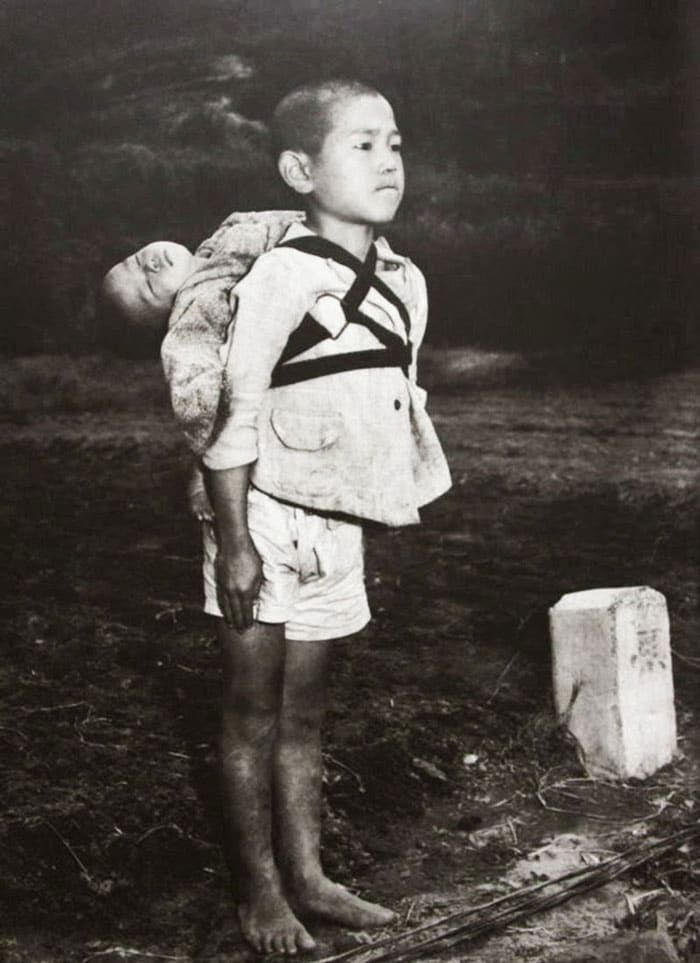 A barefoot boy waiting in line and staring ahead at a crematorium after the Nagasaki bombing, with his dead baby brother strapped to his back. Photo by US Marine photographer Joe O’Donnell
A barefoot boy waiting in line and staring ahead at a crematorium after the Nagasaki bombing, with his dead baby brother strapped to his back. Photo by US Marine photographer Joe O’Donnell
This past Memorial Day, a Minneapolis police officer knelt on the throat of an African-American, George Floyd, for 8 minutes and 46 seconds. Seventy-five years ago, an American pilot dropped an atomic bomb on the civilian population of Hiroshima. Worlds apart in time, space, and scale, the two events share three key features. Each was an act of state violence. Each was an act carried out against a defenseless opponent. Each was an act of naked racism.
The first two features—the role of the state and the impossibility of self-defense—probably require little elaboration. Each was an act of state cruelty: In one case, the agents of the state acted on home ground and in the other, on foreign ground. Each was carried out against a defenseless opponent: George Floyd’s hands were handcuffed behind him; he was not resisting arrest or putting the police officers at risk or even verbally challenging them; he used his voice merely to plead that he be permitted to breathe, then called out to his dead mother, whom he soon joined. Nor could the long line of executed black Americans who preceded George Floyd defend themselves: Breonna Taylor’s work as an emergency medical technician entailed, on a daily basis, protecting both herself and her patients, but she could not, fast asleep in bed, carry out any self-defense when Louisville police, without warrant, burst through her doors after midnight and shot her eight times.
The now widely shared recognition that police racism within the United States is not just the practice of individual officers but is instead systemic entails the recognition that African-Americans, in their interactions with the police, have ceased to have the right of self-defense, the right that arguably underlies every other right. Persons of color in the United States—including Native Americans, whose rate of death at the hands of police is the highest of any racial group[1]— cannot defend themselves. Seeing that one is about to be slain, one may try to resist (to run, to refuse handcuffing, to flail out with arms or weapon), but that resistance will then be retroactively used to justify the slaying that was already underway. One’s only choice is to comply or to resist—in other words, to be slain or to be slain.
Self-defense was not an option for any one of the 300,000 civilian inhabitants of the city of Hiroshima, nor for any one of the 250,000 civilians in Nagasaki three days later. We know from John Hersey’s classic Hiroshima that as day dawned on that August morning, the city was full of courageous undertakings meant to increase the town’s collective capacity for self-defense against conventional warfare, such as the clearing of fire lanes by hundreds of young school girls, many of whom would instantly vanish in the 6,000° C temperature of the initial flash, and others of whom, more distant from the center, would retain their lives but lose their faces.[2] The bombing of Hiroshima and Nagasaki initiated an era in which—for the first time on Earth and now continuing for seven and a half decades—humankind collectively and summarily lost the right self-defense. No one on Earth—or almost no one on Earth[3]—has the means to outlive a blast that is four times the heat of the sun or withstand the hurricane winds and raging fires that follow.
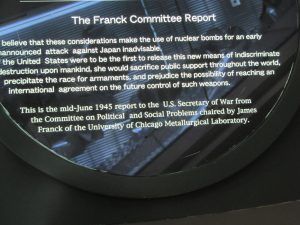
Is it accurate to designate self-defense the right underlying every other right? Freedom of speech matters for thousands of reasons, but at its most elementary, it matters because it increases one’s chance of defending oneself and by this act, surviving. The same is true of the right of free press, the right of free assembly, the right to a fair trial, the right not to be subject to warrantless search and seizure: Each has a vast array of benefits, but the bottom line is that each amplifies the right of self-defense, the right to protect and thereby perpetuate one’s own life. Centuries of political philosophers have asked, “What kind of political arrangements will create a noble and generous people?” Surely such arrangements cannot be ones where a handful of men control the means for destroying at will everyone on Earth from whom the means of self-defense have been eliminated.
The third link between Memorial Day 2020 and August 6 and 9, 1945 is the racism that made each event possible. Racism is a perceptual deformation that results in the judgement that people of a given skin color or ethnic derivation are not simply less deserving (of jobs, education, money, medical care, trust, responsibility, forgiveness, sympathy) but are, in a word, expendable. Lynch them, choke them, burn their faces off; we can do a follow-up study later.
When Americans first learned that the people of Hiroshima and Nagasaki had been collectively vaporized in less time than it takes for the heart to beat, many cheered. But not all. Black poet Langston Hughes at once recognized the moral depravity of executing 100,000 people and discerned racism as the phenomenon that had licensed the depravity: “How come we did not try them [atomic bombs] on Germany… . They just did not want to use them on white folks.”[4] Although the building of the weapon was completed only after Germany surrendered on May 7, 1945, Japan had been designated the target on September 18, 1944, and training for the mission had already been initiated in that same month.[5] Black journalist George Schuyler wrote: “The atom bomb puts the Anglo-Saxons definitely on top where they will remain for decades”; the country, in its “racial arrogance,” has “achieved the supreme triumph of being able to slaughter whole cities at a time.”[6] Still within the first year (and still before John Hersey had begun to awaken Americans to the horrible aversiveness of the injuries), novelist and anthropologist Zora Neale Hurston denounced the US president as a “butcher” and scorned the public’s silent compliance, asking, “Is it that we are so devoted to a ‘good Massa’ that we feel we ought not to even protest such crimes?”[7] Silence—whether practiced by whites or people of color—was, she saw, a cowardly act of moral enslavement to a white supremacist.
Each of these three passages, and scores of others, are documented in Vincent Intondi’s brilliant history, African-Americans Against the Bomb, which chronicles the repudiation by the Black community of nuclear arms from the 1940s up through President Obama’s April 5, 2009 Prague speech: jazz saxophonist Charlie Parker, composer and pianist Duke Ellington, civil rights and gay activist Bayard Rustin, poet-novelist James Baldwin, playwright Lorraine Hansberry, civil rights leader Rev. Martin Luther King, and sociologist and pan-Africanist W.E. B. DuBois are among those who spoke out decisively and often. During these same decades, many white people also spoke out against the moral depravity of nuclear weapons, some even suffering terrible costs similar to those suffered by, for example, DuBois, who because of his ardent denunciation of the American nuclear arsenal was at various points arrested, accused of being an unregistered foreign agent, denied a passport, and eventually prompted to expatriate to Ghana.[8] But African-Americans, in addition to educating all who would hear about the moral depravity of the inflicted injuries, have also sought tirelessly to educate the country about the racial scaffolding that provides the gantry on which the missiles are launched.
Some readers will recognize as self-evident the US addiction to white racial supremacy that was at work in the flattening of Hiroshima and Nagasaki and that today supports the country’s prodigious nuclear arsenal, currently undergoing a 1.2 trillion dollar renewal.[9] But other readers—even some who perceive the moral turpitude of nuclear weapons and who work tirelessly for their dismantlement—may be reluctant to recognize that racism. After all, we know nuclear weapons stand to eliminate all humans on Earth, not those of one or another race. Americans and Russians, who together possess more than 93 percent of the world’s nuclear arsenal, have long been designated as one another’s major opponent, and Russians are often loosely described as racially white (even though they, like the American people, are made up of many different ethnic groups). That nuclear war stands a high chance of being instigated by accident or by appropriation of the weapons by a hacker or nonstate actor may seem to make the conscious and unconscious racial biases of a United States president or nuclear command chain irrelevant.
But three lists—the list of geographies where US presidents have contemplated launching a first strike, the list of geographies where the United States has tested its bombs, and the list of countries that the United States condemns for their aspiration to acquire nuclear weapons—may, like avenues of insight radiating outward from Hiroshima and Nagasaki, help to make the racial underpinnings of the nuclear architecture unmistakable.
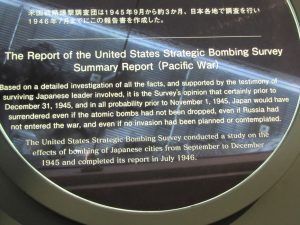
First, then, the geographies where we know presidents have contemplated first strikes. Eisenhower considered using an atomic weapon in the Taiwan Straits in 1954. The record of his statements in private meetings shows the presence of race, whether he was at any given moment explaining why he might use the weapon or instead why he might abstain from its use: “The President said that we must recognize the Quemoy is not our ship. Letters to him constantly say what do we care what happens to those yellow people out there.”[10] Nixon tells us he contemplated ordering a first strike four times during his presidency. Although he did not name all four targets, we know one in 1969 was North Korea.[11] He contemplated striking North Vietnam in 1972.[12] Lyndon Johnson contemplated the launch of a nuclear weapon against China to prevent China from acquiring a nuclear weapon.[13] To this list may be added the times when US presidents have threatened a first strike, as when the George H.W. Bush administration during the first Gulf War informed Saddam Hussein that if he used chemical weapons, nuclear missiles were positioned to strike his country.[14]
Like the countries US presidents have chosen for a first strike, the US selection of nuclear testing sites indicates a belief that people of color are expendable. The painful instance of the Marshall Islands is succinctly summarized by The Washington Post’s Dan Zak:“[T]he United States tested 67 high-yield nuclear bombs between 1946 and 1958, resettling whole islands of Marshallese people, exposing many to radioactive fallout and bequeathing exile and ill health to ensuing generations.”[15] One of the bombs was 15 megatons. Describing the total impact of the 67 tests, Zak reckons, “If their combined explosive power was parceled evenly over that 12-year period, it would equal 1.6 Hiroshima-size explosions per day.”[16] The picture is not more heartening when one turns to tests carried out on US soil. On the arrival this summer of the 75th anniversary of the July 16, 1945 Trinity test in New Mexico, observers noted the racial distribution: “It should come as no surprise that the downwinders of Trinity were largely impoverished agricultural families, mostly Hispanic and Native.”[17] As in New Mexico, so in Nevada. A study published in the medical journal Risk Analysis concludes, “Native Americans residing in a broad region downwind from the Nevada Test Site during the 1950s and 1960s received significant radiation exposures from nuclear weapons testing.”[18]
The third list is the sequence of countries we have condemned because their leaders and scientists have aspired to develop a nuclear weapon. The United States has treated these aspirants, in each case, people of color—Iranians, Iraqis, Libyans, North Koreans—as immoral, despite our own vast nuclear architecture and despite our 1995 statement at the International Court of Justice that our having a nuclear arsenal, threatening to use it, using it, and using it first do not violate international covenants such as the UN Convention on the Prevention and Punishment of the Crime of Genocide.[19] The United States sometimes bases its indignation toward nuclear aspirants on the fact that the acquisition of a nuclear weapon by yet another country will violate the Non-Proliferation Treaty (NPT); it righteously announces this violation while relentlessly overlooking the fact that it has for 50 years been in violation of that treaty, which requires, as one of its major pillars, that existing nuclear states dismantle their own arsenals.
A recent article in The Atlantic reports new neuroscience research suggesting that people holding positions of power may suffer brain damage, the incapacitation of mirror neurons that ordinarily enable one to comprehend the position of another person or people.[20] A country that has 6,000 nuclear weapons while savaging North Korea for having fewer than 30; a country that has 12 Ohio-class submarines each carrying the equivalent of 4,000 Hiroshima blasts while going to war against Iraq on false evidence that it might have material that could lead to a single nuclear weapon; a country that can’t be bothered to commemorate August 6 and August 9 and the hundreds of thousands incinerated on those days, yet clucks and scolds about Iranian nuclear projects, imposes sanctions, and unleashes a Stuxnet digital worm that subverts Iran’s uranium enrichment plant;[21] a country that persuades Libya to dispose of its nuclear materials and after it does so, swoops in to help assassinate the country’s leader, might well appear to be a country whose governors—and perhaps, too, some in its population—no longer have functioning mirror neurons.
When this soul-destroying asymmetry is pointed out, the United States says, “Yes, but they (i.e., those people of color) may use them, while we (i.e., we white people in charge of the United States) will not use them,” a manifestly incoherent statement since it is only the United States who has used them, and used them twice.[22] Extreme alarm incited by picturing nuclear weapons in the hands of yet-one-more country rarely kicks in when the United States distributes its own weapons to NATO allies, currently Germany, Belgium, Netherlands, Italy (Turkey, too, has US nuclear weapons, but many were removed after 2000 and those that remain have since 2016 become a source of mounting worry[23]). Since these four countries are traditionally viewed as white-majority peoples, the danger of reckless use is apparently non-existent; the proliferation of the weapons to these countries does not, in the US view, violate the Non-Proliferation Treaty. In a feat of double think that might have startled even George Orwell, they calmly acknowledge that in the event of war (when the NATO sharing countries will be called upon to participate in the delivery of those weapons), the Non-Proliferation Treaty will cease to be in effect.[24]
So we return to the question: What kind of political arrangements will create a noble and generous people? What kind of arrangements will restrain a country from egregious mass killings in the future? Will enable that country to face responsibility for injuries it has in the past inflicted on home ground (on Native Americans and African Americans), and on foreign ground (the people of Hiroshima and Nagasaki)? Will help them to dedicate themselves to dismantling mis-trained and militarized police teams roving their cities and dismantling the nation’s nuclear architecture? These accomplishments are momentous and difficult but surely also minimal if we aspire to one day become a great and good people.
Langston Hughes voiced the opinion that until racial injustice on home ground in the United States ceases, “it is going to be very hard for some Americans not to think the easiest way to settle the problems of Asia is simply dropping an atom bomb on colored heads there.”[25] While his statement was made in 1953, near the eighth anniversary of the Hiroshima and Nagasaki bombings, it remains equally relevant today, as we approach the 75th anniversary: Then, as now, the safety of the Korean people (among other peoples) was at issue. The cruelty daily inflicted on people of color in our own city streets acts as a mental rehearsal for carrying out large-scale slayings abroad. It keeps our capacity for cruelty limber; it dulls the mind and gives us practice in pronouncing the word “expendable.”
Langston Hughes might have with equal accuracy noted the reverse. Our cruelty abroad hardens our hearts, enabling us to tolerate the spectacle of everyday racial injustice at home. Americans, seeing our country boast a vast nuclear architecture that has no other purpose than the instant elimination from Earth of large civilian populations—the launch codes day and night casually tucked in our president’s pocket—consciously or unconsciously absorb the power lesson, suffer the same brain deterioration, and now become dull-witted about whether Native American and Black lives any longer even matter.
A just state is a state that makes its population care to be just. Can a nuclear country inspire its population to be just? Doesn’t that very nuclear architecture require its population to lose its perceptual acuity? If one keeps one’s eyes on the monumental apparatus moment by moment, that will induce incapacitating shame and terror (as happened in the first two decades after Hiroshima and Nagasaki, when the horror of the weapons and, simultaneously, of racial injustice at home, was day by day on peoples’ minds). Instead, vision has now contracted to a narrow band of bearable possibilities that, in its very narrowness, necessitates an ethical dumbing down.
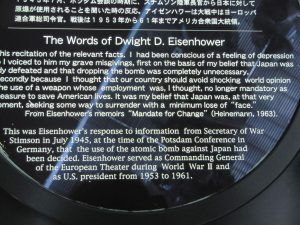
If the charge of a self-imposed dumbing down seems fanciful, it may be helpful to consider recent critiques of the country’s nuclear policy establishment. This establishment has the virtue –a virtue practiced by too few in the population – of remaining aware of the country’s nuclear arsenal; but it does so by constricting its field of vision. Anthropologist Hugh Gusterson, a longtime observer of nuclear scientists and policy communities, in early 2019 described in the pages of the Bulletin of Atomic Scientists a large assembly in Washington’s Brookings Institute that gathered to hear an all-star, five-person panel address “the Politics of New Start and Strategic Modernization.” The five, he reports, delivered five nearly identical lectures, only debating “the semantics of whether [the] pairing of nuclear modernization and arms control should be characterized as the product of a ‘consensus’ or a ‘coalition.’”[26] A related critique has been made by French political scientist Benoît Pelopidas, who describes, as his title announces, “Nuclear Weapons Scholarship as a Case of Self-Censorship in Security Studies.” Despite the absence of any externally imposed prohibition on free discourse or constraints on argument, the community voluntarily contracts the frame of reference to bypass all normative considerations and to avoid contemplating the possibility of radical reordering of the world, such as by nuclear abolition. Two terms—“non-proliferation” and “deterrence”—are relentlessly used as tools to corral the discussion into a narrow perimeter of business-as-usual thinking that invalidates as unrealistic any alternative idea, thereby eliminating any sense of obligation to the future.[27]
The death of George Floyd has brought about, among many other outcomes, a commitment to change the nuclear policy arena. In the summer of 2020, a cascade of American foreign policy and national security institutions, including the Bulletin of Atomic Scientists, signed the statement authored by the Women of Color Advancing Peace, Security and Conflict and agreed to carry out a host of reforms, such as making sure institutions dedicated to peace and security “diversify our boards of directors and advisory committees,” acknowledge the harmful effects of “microagressions” against people of color in the workplace, and “call out racism and share the burden of dismantling white supremacy.”[28]
While the list of resolutions emphasizes changes in the workplace and governing boards of these institutions, it may be that these changes will in turn bring about a recognition of the place of racism in the very philosophies of international relations and nuclear weapons. The obligation to “call out racism and share the burden of dismantling white supremacy” should carry with it the obligation to recognize the racist foundation of the nuclear architecture itself (a northern hemisphere blanketed by nuclear states, a southern hemisphere blanketed by nuclear weapons-free zone treaties) and to dismantle it, beginning with the two states that hold 93 percent of all the weapons.
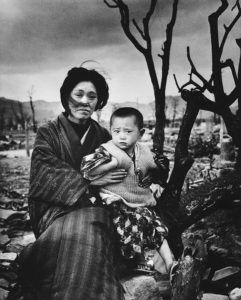
Most nights during the summer of 2020, Black Lives Matter vigils take place, not only in cities but in small towns across the country. In Arlington, Massachusetts, for example, people stand, masked and at safe distances from one another, along the broad main avenue from 6 p.m. to 7 p.m., while a stream of bicycles and cars signal by waves and horns and thumbs up their affirmation of the signs: “Breonna Taylor.” “Raychard Brooks.” “George Floyd.” “Say Their Names.” “Not One More.” “No Justice, No Peace.” In the last 8-minutes and 46 seconds of the hour, people drop to one knee and only stand again when the church bells announce the closing of the hour. The posture is one inherited from decades of civil rights practice (initiated by Martin Luther King, Jr., then made new by Colin Kaepernick and black NFL players ); the temporal duration is a direct reference to the killing of George Floyd, as though by duplicating the kneeling of the policeman we could back up and reverse its intent and its outcome. The posture expresses an array of feelings: sorrow at George Floyd’s death, a counterfactual wish that it had not happened (let his breathing be restored), shame at not having collectively perceived the scale of the injuries for so long, and a commitment to reinvent a form of policing that nourishes and assists, rather than preys upon, our towns and cities.
Perhaps something like this same gesture could be carried out—in the privacy of one’s home or on Main Street or in parks and spaces of public assembly—at 8:15 a.m. on August 6th and 11:02 a.m. on August 9. Carried out: out of sorrow for those slain and those hideously wounded, out of remorse for not having faced the injuries sooner, out of a shared commitment to dismantle the nuclear architecture so that we need only commemorate, and never again re-enact, what took place on those days. What would be an appropriate duration? Perhaps 53 seconds, the time interval between the moment the children of Hiroshima pointed to the B-29 in the blue sky and the moment a blinding flash of light melted their eyes and erased their world. Or perhaps the 100 seconds that the Bulletin designates as the window of time that now separates us from worldwide catastrophe.
Notes
[1] For a chart summarizing research by the Center for Disease Control and Prevention (CDC) on law enforcement killings of various racial groups from 1999 to 2015, see Elise Hansen, CNN, “The Forgotten Minority in Police Shootings,” November 13, 2017. https://www.cnn.com/2017/11/10/us/native-lives-matter/index.html.
Another large study has shown “Native American males have 14 times as many fatal encounters [with police] as white males; Native American females have 38 times as many fatal encounters as white females.” Matthew Harvey, The Center for Indian Country Development, “Fatal Encounters between Native Americans and the Police,” March 2020. https://www.minneapolisfed.org/~/media/assets/articles/2020/fatal-encounters-between-native-americans-and-the-police/fatal-encounters-between-native-americans-and-the-police_march-2020.pdf?la=en
[2] John Hersey, Hiroshima (New York: Vintage, 1946, 1984; 2nd edition 2020), pp. 35, 181, 146, 167 168, 183-5, 191.
[3] I stipulate “almost” no one on Earth because the people of Switzerland, acting on an ethic of “equality of survival,” have created fallout shelters for 114 percent of their population (as well as many hospitals and first aid stations hidden inside mountains); conceivably, some among them may survive. The United States has spent equally vast resources on a fallout shelter for a single person, the president, and his entourage—a miniature city carved out inside a mountain—but no shelter for the population. For the contrast between the Swiss and US shelter systems, see Elaine Scarry, Thinking in an Emergency (New York: Norton, 2011), pp.51-69; and for a detailed account of the U.S. shelter, see Garrett M. Graff, Raven Rock: the Story of the U.S. Government’s Secret Plan to Save Itself – While the Rest of Us Die (New York: Simon and Schuster, 2017).
[4] Langston Hughes, “Here to Yonder: Simple and the Atom Bomb,” Chicago Defender, August 19, 1945, cited in Vincent Intondi, African Americans Against the Bomb: Nuclear Weapons, Colonialism, and the Black Freedom Movement (Stanford, Ca.: Stanford University Press, 2015), p. 15.
[5] Richard Rhodes describes President Roosevelt’s and Prime Minister Churchill’s September 18-19, 1944 meeting at Roosevelt’s Hudson Valley estate, Hyde Park, and “a secret aide-mémoire” that “recorded for the first time the Anglo-American position on the new weapon’s first use.” The document contemplates bombing multiple Japanese cities, with a warning coming only after the first city has been struck: “when a ‘bomb’ is finally available, it might perhaps, after mature consideration, be used against the Japanese, who should be warned that the bombardment will be repeated until they surrender.” The fall 1944 training of the 509th Composite Group in Utah entailed visual targeting, something that puzzled the crews since they were used to “cloudy Europe” where visual identification of a target was seldom possible. (Richard Rhodes, The Making of the Atomic Bomb [New York: Simon & Schuster, 1986, 2012], pp. 537, 585).
[6] George Schuyler, “Views and Reviews,” Pittsburgh Courier, August 18, 1945 and December 15, 1945, cited in Intondi, African Americans Against the Bomb, p. 14.
[7] Zora Neale Hurston, letter to Claude Barnette, July 21, 1946, published in Zora Neale Hurston: A Life in Letters, ed. Carla Kaplan (New York: Doubleday, 2002), p. 545, and cited in Intondi, African Americans Against the Bomb, p. 15.
[8] W.E.B. DuBois, In Battle for Peace: the Story of My 83rd Birthday, introd. Manning Marable (New York: Oxford University Press, 2007), pp. xxi, xxiii, xxv, 23, 26-27, 37, 48, 49, 137, 144.
[9] The Endowment for Human Development calculates that a billion dollars is a stack of hundred dollar bills 70 miles high, whereas one trillion dollars is a stack of hundred dollar bills 68,000 miles high or “more than one-fourth the way from the earth to the moon.” https://www.ehd.org/science_technology_largenumbers.php
[10] Foreign Relations of the United States, 1952-54, vol. 14, p. 622. Eisenhower also considered using a nuclear weapon in 1959 in Berlin, a white population. I describe these events where presidents considered using an atomic weapon in Thermonuclear Monarchy: Choosing between Democracy and Doom (New York: Norton, 2014).
[11] “Memorandum: Secretary of Defense Laird to NSA Kissinger, June 25, 1969. Subject: Review of US Contingency Plans for Washington Special Action Group,” Tab L, declassified October 2006 (Document 12, “How Do You Solve a Problem Like Korea,” Electronic Briefing Book 322, National Security Archive, George Washington University). See also Chris McGreal, “Papers Reveal Nixon Plan for North Korea Nuclear Strike,” Guardian, July 7, 2010.
[12] On Nixon’s 1972 proposal to use nuclear weapons in North Vietnam, see Deb Riechmann, “Nixon Discussed Nuclear Strike in Vietnam,” Boston Globe, March 3, 2002.
[13] On the release of documents showing Johnson’s consideration of a pre-emptive strike in China, see Jim Mann, “U.S. Considered ’64 Bombing to Keep China Nuclear-Free,” Los Angeles Times, September 27, l998.
[14] Nick Pike, “Nuclear Threats during the Gulf War,” Federation of American Scientist, February 19, 1998. Threats made by the United States and the United Kingdom included total destruction of the country: For example, British Foreign Minister Douglas Hurd warned against any action that would “provoke a response that would completely destroy that country.” https://fas.org/irp/eprint/ds-threats.htm. For an account of U.S. and British threats against Iraq, as well as U.S. and British use of depleted uranium munitions against Iraq, see Joseph Gerson, Empire of the Bomb: How the U.S. Uses Nuclear Weapons to Dominate the World (Ann Arbor, Michigan: Pluto Press, 2007), p.217f.
[15] Dan Zak, “He saw a nuclear blast at 9, then spent his life opposing nuclear war and climate change,” Washington Post, August 24, 2017. Available at: https://www.washingtonpost.com/local/he-saw-a-nuclear-blast-at-9-then-spent-his-life-opposing-nuclear-war-and-climate-change/2017/08/24/5b6d10e6-882e-11e7-a94f-3139abce39f5_story.html
[16] Dan Zak, “A Ground Zero Forgotten: The Marshall Islands, Once a U.S. Nuclear Test Site, Faces Oblivion Again,” Washington Post, November 27, 2015. Available at: https://www.washingtonpost.com/sf/national/2015/11/27/a-ground-zero-forgotten/
[17] Joshua Wheeler, “It’s Been 75 Years, and American Still Won’t Admit a Nuclear Disaster,” New York Times, July 16, 2020. The presence of Hispanic families is also noted by Maria Cramer, who writes, “Officials did not warn any of the residents — many of them ranchers, Navajos, Mexican settlers and their descendants who raised cattle and drank water from cisterns — about the test” (“’Now I Am Become Death’: The Legacy of the First Nuclear Bomb Test,” New York Times, July 15, 2020).
A 2010 study by the Center for Disease Control and Prevention (CDC) reports: “Different standards of safety were applied to informed project workers than to uninformed members of the public. Project workers knew enough to evacuate areas when high exposure rates were measured, or to take the necessary precautions to minimize exposure, but members of the public did not realize that changes in their behavior were prudent, and project staff did not call for evacuations or protective measures even though predetermined tolerances for exposure rate and projected total exposure had been exceeded.” Addressing the racial composition of residents living near the test site, the report notes that General Leslie Groves stipulated “a 17 x 24 mile area on which no Native Americans lived.” A chart summarizing the racial composition of nearby residents specifies the presence of whites and Hispanics but not Native Americans. CDC, “Final Report of the Los Alamos Historical Document Retrieval and Assessment (LAHDRA) Project,” November 2010, pp. 10-3, 10-15, 10-50.
A wider perimeter, however, reveals the presence of many Native Americans. Indian Country Today states that the 19,000 people living within a 50-mile radius of the Trinity test site included 19 Pueblo communities, two Apache tribes, and several “chapters of the Navajo Nation.” Tanya H. Lee, “H-Bomb Guinea Pigs! Natives Suffering After New Mexico Tests,” Indian Country Today, March 5, 2014, https://indiancountrytoday.com/archive/h-bomb-guinea-pigs-natives-suffering-decades-after-new-mexico-tests-jpZAFe1gFEmRCGfiq42BDg
[18] E. Frohmberg, R. Goble, V. Sanchez, D. Quigley, “The Assessment of Radiation Exposures in Native American Communities from Nuclear Weapons Testing in Nevada,” Risk Analysis, February 2000, pp. 101-111.
[19] Department of State and Department of Defense, “Written Statement of the Government of the United States,” International Court of Justice, Hearings on the questions: “Is the threat or use of nuclear weapons in any circumstance permitted under international law?”, 1995, p.33
[20] Jerry Useem, “Power Causes Brain Damage: How Leaders Lose Mental Capacities – Most Notably for Reading Other People – that Were Essential to Their Rise,” The Atlantic, July/August 2020. The research —showing that people with power became “less adept at seeing things from other people’s point of view” as well as “more impulsive, less risk-aware”—was carried out in separate studies by psychologist Dacher Keltner at UC Berkeley and neuroscientist Sukhvinder Obhi at McMaster University in Ontario.
[21] Kim Zetter, “How Digital Detectives Deciphered Stuxnet, the Most Menacing Malware in History,” Wired, July 11, 2011. See also the documentary film, Zero Days, directed by Alex Gibney, 2016.
[22] Anthropologist Hugh Gusterson calls this asymmetry in U.S. thinking “nuclear orientalism,” the belief that other countries are “too infantile, too immature, and too irresponsible to be trusted with nuclear weapons.” See his vividly illustrated lecture, “Democracy, Hypocrisy, First Use,” at the Nov. 4, 2017 Harvard conference, “Presidential First Use: Is it Legal? Is it Constitutional? Is it Just?” , https://www.youtube.com/watch?v=zdLXKNivl9M&list=PL2SOU6wwxB0vZEgAvRotf9-INc9nA8t02&index=10&t=0s. To read a transcript (without visual illustrations), see Public Books, “Virtual Roundtable on Presidential First Use of Nuclear Weapons,” February 26, 2018.
[23] See Hans Kristensen, “Urgent: Move US Nuclear Weapons Out of Turkey,” Federation of American Scientists, October 16, 2019.
[24] “Questions on the Draft Non-Proliferation Treaty Asked by U.S. Allies Together with Answers Given by the United States,” April 28, 1967, Tab A, connected to April 10, 1968 “Letter from the Under Secretary of State (Katzenbach) to Secretary of Defense Clifford,” Foreign Relations of the United States, 1964-68, Vol. XI, Arms Control and Disarmament, p. 575.
[25] Langston Hughes, “Colored Asia Makes Highly Colored News These Days,” Chicago Defender, August 15, 1953, p. 11, cited in Intondi, African Americans Against the Bomb, p. 31.
[26] Hugh Gusterson, “The Blinders on the U.S. Nuclear Policy Establishment,” Bulletin of Atomic Scientists, January 8, 2019.
[27] Benoît Pelopidas “Nuclear Weapons Scholarship as a Case of Self-Censorship in Security Studies,” Journal of Global Security Studies, 2016. Available at: https://spire.sciencespo.fr/hdl:/2441/7leam5bkng9j3binvavkneitle/resources/2016-pelopidas-nuclear-weapons.pdf
[28] Gayle Spinazze, WCAPS Statement: Standing Together Against Racism and Discrimination,” Bulletin of the Atomic Scientists, June 10, 2020. As Rachel Bronson wrote in signing the statement, “The Bulletin recognizes racism as a threat to humanity and that national security cannot be advanced unless all citizens have strong personal security. . . .We acknowledge that we have much work to do on this front to serve as an ally with communities of color, and those advocating change.” Available at: https://thebulletin.org/2020/06/wcaps-statement-standing-together-against-racism-and-discrimination/
Together, we make the world safer.
The Bulletin elevates expert voices above the noise. But as an independent nonprofit organization, our operations depend on the support of readers like you. Help us continue to deliver quality journalism that holds leaders accountable. Your support of our work at any level is important. In return, we promise our coverage will be understandable, influential, vigilant, solution-oriented, and fair-minded. Together we can make a difference.
Keywords: African Americans Against the Bomb, George Floyd, Hiroshima, Nagasaki, racism
Topics: Hiroshima & Nagasaki, Nuclear Risk, Nuclear Weapons
Share: [addthis tool="addthis_inline_share_toolbox"]


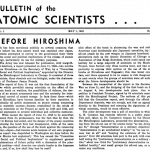


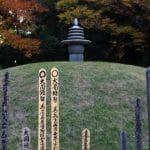









I’m not sure I understand the premise of this article. There is an aspect of US nuclear policy that is racialized, just as there is an aspect of all American policy that is racialized. However, the analogy between the murder of George Floyd and the atrocity of the atomic bombings is tenuous. The Pacific War, like the Eastern Front, is a conflict in which both sides adopt racist/supremacist ideas to justify wartime atrocities and their perception of the enemy; however, the dropping of the bomb is not “an act of naked racism” unless you categorize all acts of the war… Read more »
Does anyone recognize the 3 days between the bombs? After the first was dropped, we offered peace if the Japanese would surrender. They did not The Japanese, having killed millions of Chinese, and Koreans, attacked the US, Britain and all their allies were not going to surrender and they said as much. How much responsibility does the Japanese govt get for having invited the second bomb, promised if they did not surrender? We have done a lot of truly awful things. Not sacrificing hundreds of thousands of Allies lives on an invasion wasn’t one of them. The Japanese are, perhaps,… Read more »
The premise of the article is that the United States is racist and evil.
What a strange article, and actually shockingly obtuse for a Harvard professor. I look and look and look for any reference in Scarry’s article to the fact that the Japanese had started a war, were advancing their imperialistic ambitions, and had their own racial theories, which they employed with brutality. They were responsible for at least a million deaths, and some estimate 6 million. We can argue about the use of the atomic bomb against civilians, but it has to be seen in this context. As for Langston Hughes’ rhetorical question, why not the Germans?. It hardly makes sense to… Read more »
Ironically the Japanese themselves were motivated by an ideology of racial supremacy as evidenced by their treatment of allied prisoners of war and the atrocities commited against the civilian populations of China and South East Asia. I am sure the author must be aware of this but for reasons of their own they have decided to ignore it.
Excellent article, I am surprised it got published in The Bulletin. Don’t be disheartened by the fact that most on this site won’t be able to comprehend the racist underpinnings of what they call the ‘rules based (Western) world order’–rules for others that is, not for themselves. Most Westerners still suffer from a deeply embedded racism that was stewed to perfection in hundreds of years of utterly savage colonialism. The very first comment by Paul proves your point that nuclear weapons scholarship, if you can even call it scholarship, is incapable of comprehending moral arguments, it gets bogged down in… Read more »
“Each was an act carried out against a defenseless opponent. Each was an act of naked racism.” Let’s see. At the time we dropped the A-Bombs Japan had several million armed men in the Japanese Home Islands, the civilian population had largely been mobilized and organized into rudimentary military units, the Japanese Army had a veto over Japanese government policy and was ready to fight to the death. That’s a defenseless opponent? If it had been finished in time to drop on Germany is there any doubt we would have used it on them? Hey, wait a minute, the Germans… Read more »
No, it wasn’t racism. We dropped nuclear bombs on Japan because we were at war with the Japanese. Japanese is a nationality, not a race.
Dropping the bomb on Nagasaki and Hiroshima had nothing to do with racism. How many books and articles have you read about World War II? Drawing an analogy between the George Floyd case and the dropping of the bomb is ludicrous .